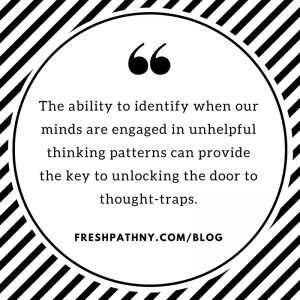8 Common Thought-Traps

Unhelpful Thinking Patterns
The mind is fascinating, complex, complicated and, sometimes, a bit of a trickster. It can have a lot of fun creating thought patterns that can lead to increased emotional distress. If you are not paying close attention, you may find yourself believing in particularly unhelpful thoughts and that can lead to negative changes in behavior and in mood. The ability to identify when our minds are engaged in unhelpful thinking patterns can provide the key to unlocking the door to thought-traps. Some common unhelpful thinking patterns are outlined below. Do any of these apply to you?
1. Labelling:
This is a common thought-trap that involves attaching a label to yourself, someone else, or a behavior. Maybe you are upset about a mistake that you made at work. Suddenly, you find yourself thinking: I’m such an idiot! I’m a terrible employee! That’s a thought-trap! Rather than acknowledging that you (and everyone else in the world) makes mistakes sometimes, you’ve labelled yourself something negative. Try catching yourself when you might be engaged in labelling and see if you can create a more accepting, non-judgmental way of describing the situation and yourself.
2. Mental Filter:
In this thought-trap, your mind tends to zoom in on negative aspects while ignoring the everything else. Perhaps you have just made a presentation and in the feedback notes you receive 9 positive reviews and 2 negative. When your mental filter turns on, you might find yourself thinking ONLY about the negative reviews. This might actually lead you to feel poorly about your presentation and behave as though you did everything wrong (you might even turn down the next opportunity to present). Was there room for improvement? SURE! Additionally, there were positive notes that you did receive. Get out of this though-trap by taking into account the full picture.
3. Blame:
In the thought-trap of blame, accountability is placed in all the wrong places. Your mind quickly puts full blame and another person or yourself for circumstances that were not within personal control. For example, if your partner were to come home upset, this thought-trap might lead you to think: If I were a better partner, they would not feel upset when they came home. This line of thinking completely discounts the work stress, lack of lunch, and stressful commute that your partner experienced during their day. Holding yourself (or someone else) completely accountable for a situation does not allow for the full picture to unfold.
4. All or Nothing:
This thought-trap is a classic! Also known as black-and-white thinking, this thought-trap leads one to believe that there is no in-between. There is only good or bad; black or white; all or nothing. This thought-trap will quickly have you  thinking that your whole week is a waste if you did not accomplish some of your tasks for the week. A quick way to get out of this trap is to consider all and nothing as the two end points on either end of a spectrum. That opens up a lot of space in-between for you to locate what’s happening.
thinking that your whole week is a waste if you did not accomplish some of your tasks for the week. A quick way to get out of this trap is to consider all and nothing as the two end points on either end of a spectrum. That opens up a lot of space in-between for you to locate what’s happening.
5. Discounting the Positive:
This thought-trap works by dismissing positive experiences through negative self-talk. If someone does something nice for you, this thought-trap might instead produce the thought: They probably do that for everyone. If you get a new job, your mind might dampen that positive experience by thinking: They probably couldn’t find anyone else. This thought-trap makes it very difficult to enjoy the highlights of your life. The trick out of this trap is to simply accept what has happened without judgment. (“I got a new job.”) and try using language that invokes pride, accomplishment, and gratitude. (“I’m pleased that co-worker did something nice for me today.”)
6. Magnification:
Think of a magnifying glass and you’ll understand the thought-trap of magnification. The thought zooms in on one thing and explodes it so that it takes up our full attention. Think of it this way – it’s like focusing on the tree instead of the forest or the pain in your leg but missing all the other well-working parts of your body. This thought-trap thrives on removing your from the big picture. Try expanding your vision to find a quick release from this trap.
7. Overgeneralizing:
Ever hear someone use the words “always” or “never” to describe a behavior or situation? “My friends never show up on time!” “People are always rude to me.” That’s overgeneralizing hard at work. This thought-trap works by eliminating all memory and evidence for times when something did or did not happen. If you catch yourself thinking about something in “always” or “never” terms, ask yourself, is that true? Is there anytime in my history that presents evidence that that is not true?
8. Jumping to Conclusions:
This particular thought-trap comes in different forms. One version of it tricks us into thinking we absolutely know what’s going to happen in the future. Often times, we predict the worst case situation, also known as catastrophizing. Another form of this thought-trap is that we are tricked into thinking we know what other people are thinking about us. This “mind-reading” can be problematic as it can deeply and negatively impact our relationships with others. Run down that “parade of terribles” until you get to the end and employ “reality-checking” to stop this unhelpful trap.
© Copyright 2017 FreshPathNY.com. All rights reserved. Contributed by Deanna Richards, LMHC
